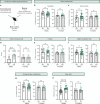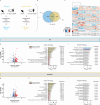Characterization of Neurensin-2 knockout mice: insights into stress-resilience mechanisms
- PMID: 40603293
- PMCID: PMC12223177
- DOI: 10.1038/s41398-025-03448-7
Characterization of Neurensin-2 knockout mice: insights into stress-resilience mechanisms
Abstract
Major depressive disorder (MDD) affects millions worldwide, yet its pathophysiology remains poorly understood. While some individuals are susceptible to developing depression, others show resilience that protects them from developing MDD. Understanding the resilience-associated mechanisms will likely result in novel therapies for MDD. We have recently reported that the vesicular protein Neurensin-2 mediates depression and that its deletion confers profound resilience to chronic stress. Nonetheless, the behavioral and molecular adaptations that underlie the stress resilience in Neurensin-2 knockout mice are still unknown. In this study, we aimed to comprehensively characterize the basal behavioral effects of Neurensin-2 deletion in mice. We used Neurensin-2 knockout male and female mice to examine how Neurensin-2 deletion affects cognitive, emotional, and motor performance in mice. In addition, we examined the impact of Neurensin-2 deletion on body weight, analyzed the stress-induced molecular changes, and tested how these changes affect the excitatory/inhibitory balance. We found that while Neurensin-2 deletion confers basal anxiolysis and weight reduction, no discernible cognitive, social, or motor impairments were detected. Furthermore, we found that Neurensin-2 knockout mice have impaired hippocampal inhibitory transmission, which is resilient to the stress-evoked excitatory/inhibitory imbalance seen in wild-type mice. Our findings suggest that Neurensin-2 deletion confers basal anxiolysis, and shifts the hippocampal excitatory/inhibitory balance. These effects are not accompanied by impaired cognitive function or weight gain. Thus, we suggest Neurensin-2 inhibition as an exciting potential strategy for developing treatments for depression and anxiety disorders as well as for promoting stress resilience.
© 2025. The Author(s).
Conflict of interest statement
Competing interests: The authors declare no competing interests.
Figures





Similar articles
-
Pre-deployment programmes for building resilience in military and frontline emergency service personnel.Cochrane Database Syst Rev. 2021 Dec 6;12(12):CD013242. doi: 10.1002/14651858.CD013242.pub2. Cochrane Database Syst Rev. 2021. PMID: 34870330 Free PMC article.
-
Systemic pharmacological treatments for chronic plaque psoriasis: a network meta-analysis.Cochrane Database Syst Rev. 2021 Apr 19;4(4):CD011535. doi: 10.1002/14651858.CD011535.pub4. Cochrane Database Syst Rev. 2021. Update in: Cochrane Database Syst Rev. 2022 May 23;5:CD011535. doi: 10.1002/14651858.CD011535.pub5. PMID: 33871055 Free PMC article. Updated.
-
Psychological therapies for the management of chronic and recurrent pain in children and adolescents.Cochrane Database Syst Rev. 2018 Sep 29;9(9):CD003968. doi: 10.1002/14651858.CD003968.pub5. Cochrane Database Syst Rev. 2018. PMID: 30270423 Free PMC article.
-
Music interventions for improving psychological and physical outcomes in cancer patients.Cochrane Database Syst Rev. 2016 Aug 15;(8):CD006911. doi: 10.1002/14651858.CD006911.pub3. Cochrane Database Syst Rev. 2016. Update in: Cochrane Database Syst Rev. 2021 Oct 12;10:CD006911. doi: 10.1002/14651858.CD006911.pub4. PMID: 27524661 Updated.
-
Omega-3 fatty acids for depression in adults.Cochrane Database Syst Rev. 2021 Nov 24;11(11):CD004692. doi: 10.1002/14651858.CD004692.pub5. Cochrane Database Syst Rev. 2021. PMID: 34817851 Free PMC article.
References
-
- World Health Organisation. Depression and Other Common Mental Disorders: Global Health Estimates. Geneva; 2017
-
- Gold PW. The organization of the stress system and its dysregulation in depressive illness. Mol Psychiatry. 2015;20:32–47. - PubMed
-
- Connor KM, Davidson JRT. Development of a new resilience scale: the connor-davidson resilience scale (CD-RISC). Depress Anxiety. 2003;18:76–82. - PubMed
MeSH terms
Grants and funding
LinkOut - more resources
Full Text Sources
Medical

